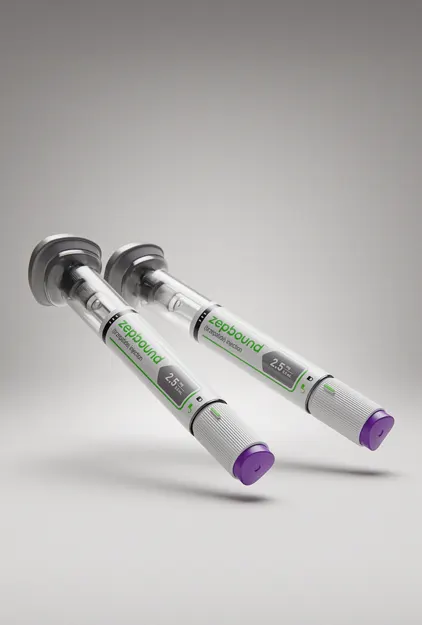Zepbound vs. Mounjaro: What is the difference?

Reviewed by Raagini Yedidi, MD,
Written by Amelia Willson
last updated: May 07, 2024
9 min read
Key takeaways
Zepbound and Mounjaro share the same active ingredient, tirzepatide.
Other similarities include their dosage schedules and method of administration (subcutaneous injection)
The main difference between Zepbound vs. Mounjaro is that they are FDA-approved to treat different health conditions.
Zepbound is indicated for weight loss, while Mounjaro is indicated for type 2 diabetes.
There are a few other nuances between Zepbound and Mounjaro, including their side effects, cost, and insurance coverage.
Here's what we'll cover
If you are looking to manage your type 2 diabetes or lose weight (or both), your health provider may have suggested Mounjaro or Zepbound as potential treatment options. Both of these medications are made by the same company (Eli Lilly), contain the same active ingredient (tirzepatide), and share similar side effects (nausea, vomiting, and diarrhea, among others). So, what’s the difference?
The main difference between Zepbound vs. Mounjaro is that they are FDA-approved to treat different health conditions: weight loss in the case of Zepbound, and type 2 diabetes in the case of Mounjaro. One medication may be a better fit for you than the other, depending on your personal health situation, insurance coverage, and other considerations. Read on as we break down the differences and similarities between Mounjaro and Zepbound.
Mounjaro Important Safety Information: Read more about serious warnings and safety info.
Zepbound Important Safety Information: Read more about serious warnings and safety info.

Weight loss
Get Zepbound
Lose up to 20% body weight in a year, if prescribed.
Weight loss claims apply to branded medications. Limited availability of some doses of Zepbound. See Important Safety Information
What is Zepbound?
Zepbound (tirzepatide) is a once-weekly injectable prescription medication for weight loss that’s intended to be used with diet and exercise. Zepbound is made by Eli Lilly and was approved by the FDA in 2023. Zepbound may be prescribed to people who have a body mass index (BMI) of:
30 or greater (defined as “obesity”); or
27 or higher (defined as “overweight”) and a weight-related health condition, such as high blood pressure, high cholesterol, type 2 diabetes, obstructive sleep apnea, or heart disease
Zepbound is injected once a week subcutaneously (under the skin) of the stomach, thigh, or upper arm. It is available in six dosage strengths ranging from 2.5 milligrams (mg) to 15 mg, with 5 mg, 10 mg, and 15 mg being the maintenance dosages. Providers typically prescribe a starting dosage of 2.5 mg before gradually increasing the dosage over a period of weeks to months until an effective dosage is reached. This titration schedule helps keep side effects manageable while your body gets used to the medication.
What is Mounjaro?
Mounjaro (tirzepatide) is a once-weekly injectable prescription medication for type 2 diabetes. In combination with diet and exercise, Mounjaro treats type 2 diabetes by improving blood sugar control. It is made by Eli Lilly and was FDA-approved in 2022.
Mounjaro is injected once a week under the skin of the stomach, thigh, or upper arm. It is available in the same six dosage strengths as Zepbound, including the 5 mg, 10 mg, and 15 mg maintenance dosages. To keep side effects manageable, health providers typically start at a dosage of 2.5 mg before gradually increasing the dosage over several weeks until blood sugar levels are adequately controlled.
Mounjaro vs. Zepbound: Comparing the two
Mounjaro and Zepbound may have different brand names and indications, but the medications have many similarities. Below, we explore the differences and similarities between Mounjaro and Zepbound.
Active ingredients
Mounjaro and Zepbound both contain the same active ingredient, tirzepatide. Tirzepatide works by mimicking two hormones produced naturally in your gut: glucagon-like peptide-1 (GLP-1) and glucose-dependent insulinotropic polypeptide (GIP).
GLP-1 slows down digestion by moving food more slowly from your stomach to your intestine after you eat (a process called gastric emptying). At the same time, it boosts the release of insulin and inhibits the release of glucagon. GIP enhances these insulin-boosting and glucagon-lowering effects, and helps your body burn fat better. Together, these effects help lower blood sugar levels, while also making you feel full sooner — which may cause you to eat less and lose weight as a result. Additionally, research suggests that both GLP-1 and GIP have effects on your brain that influence your appetite and satiety.
When Mounjaro was released, it was the first in its class to target both the GLP-1 and GIP receptors, making it unique among other injectable medications for type 2 diabetes or weight loss, such as Ozempic (semaglutide) or Wegovy (semaglutide), which only target a single receptor, GLP-1. This unique ability to target two receptors may explain why tirzepatide can be more effective than other GLP-1 medications at both improving blood sugar levels and weight loss.
Ozempic Important Safety Information: Read more about serious warnings and safety info.
Wegovy Important Safety Information: Read more about serious warnings and safety info.
Side effects
Zepbound and Mounjaro share a similar list of gastrointestinal side effects, which usually range from mild to moderate. Common side effects include:
Nausea
Diarrhea
Decreased appetite
Vomiting
Constipation
Upset stomach or indigestion
Abdominal pain
Additional Zepbound side effects may include injection site reactions (e.g. bruising, rash, or irritation at the injection site), fatigue, allergic reactions (typically rash and itching), belching, hair loss, and acid reflux.
While rare, serious side effects can occur with either medication. These may include:
Severe gastrointestinal disease
Acute kidney injury
Acute gallbladder disease
Acute pancreatitis
Serious allergic reaction
Hypoglycemia (low blood sugar) in people also taking insulin or insulin secretagogues
Diabetic retinopathy (vision damage or changes) in people with type 2 diabetes
Depression, suicidal behavior, or ideation have also been reported with Zepbound.
Providing your healthcare provider with a full personal and family medical history, along with a list of any drugs or supplements you are taking, can help them ensure Zepbound or Mounjaro will be safe for you. Taking the medication as prescribed may help reduce the digestive side effects common to either medication. So can dietary changes such as:
Drinking lots of healthy liquids
Eating easily digestible foods or bland foods like toast, crackers, or rice
Avoiding spices, fried foods, alcohol, and fatty foods
Eating smaller meals more frequently vs. larger meals less often
No longer eating once you feel full
FDA approval
The FDA first approved tirzepatide to treat type 2 diabetes in May 2022. Marketed under the brand name Mounjaro, the drug is a second-line treatment for type 2 diabetes, recommended for people whose blood sugar levels did not adequately improve with diet and exercise alone or with other diabetes treatments. Mounjaro should be used in combination with diet and exercise. It is not FDA-approved for weight loss, though some providers may prescribe it off-label for this purpose.
In clinical trials, researchers found Mounjaro to be even more effective than other GLP-1 medications in improving blood sugar levels. It was also found to be highly effective in producing weight loss, leading healthcare providers to prescribe the medication off-label for obesity.
In November 2023, the FDA approved Zepbound as a treatment for chronic weight management in people with obesity (BMI of 30 or higher) or overweight (BMI of 27 or higher) with a weight-related health condition such as high blood pressure, high cholesterol, or type 2 diabetes. Like Mounjaro, it is also meant to be used in combination with a reduced-calorie diet and increased physical activity.
Availability of Mounjaro, Zepbound
Both Mounjaro and Zepbound have experienced drug shortages since their initial approval and release. The demand for both medications is unprecedented, and although Eli Lilly continues to ramp up production, Reuters reports that they expect ongoing shortages throughout 2024.
According to the FDA Drug Shortages website, only the starting 2.5 mg dosage of Mounjaro and Zepbound is widely available at the time of writing. The 5 mg, 7.5 mg, 10 mg, 12.5 mg, and 15 mg dosage strengths of both medications are listed as having limited availability which is anticipated through the end of June 2024.
Cost difference between Mounjaro and Zepbound
There is about a $10 cost difference between Mounjaro and Zepbound. Without insurance, the list price of Mounjaro is approximately $1,069.08 for a 4-week supply. The cost of Zepbound is slightly lower, with a list price of $1,059.87 according to the manufacturer. List price describes the price at which a drug manufacturer sells its drugs to a wholesaler. The price you pay at the pharmacy to fill your prescription of Mounjaro or Zepbound may be higher or lower, depending on the pharmacy you use and your insurance coverage.
Eli Lilly offers savings programs for both drugs, which may bring down the price of either medication. Neither program is available to people with insurance through a state or federal program like Medicaid, Medicare, Medigap, DoD, VA, or TRICARE. You can also find individual coupons for different pharmacy chains on websites like GoodRx.
The Mounjaro Savings Card program is available to people with commercial insurance. The program offers savings of up to $150 per refill for people with coverage for Mounjaro, and up to $573 per refill for people without coverage for Mounjaro.
The Zepbound Savings Card program is available to people with commercial insurance. The program offers savings of up to $150 per refill for people with coverage for Zepbound, and up to $563 per refill for people without coverage for Zepbound.
Zepbound vs. Mounjaro insurance coverage
Insurance coverage and copays for Zepbound vs. Mounjaro can differ based on your plan. Because both drugs are newer, they may not yet be covered by your particular insurance plan. To know if Zepbound or Mounjaro is covered by your plan, review your plan’s drug formulary or contact your health insurance provider.
Insurance coverage for Zepbound
Commercial insurance plans can vary in their coverage of anti-obesity medications like Zepbound. Consult your plan’s drug formulary to see if Zepbound is covered. In some cases, your healthcare provider may need to submit a prior authorization on your behalf to request coverage. If you have commercial drug insurance — whether or not it includes coverage for Zepbound — you may be eligible for the Zepbound Savings Card program, which can bring the cost of your copay down to as little as $25 for a one-month supply.
Medicare typically does not cover anti-obesity medications like Zepbound, but some Medigap and Medicare Advantage plans do in certain situations. Similarly, other government and state or federal-funded healthcare plans may differ in their coverage of Zepbound, including Veterans Affairs, TRICARE, and Medicaid. If you have coverage through the VA, you may be able to get Zepbound covered under the MOVE! Program. Contact your VA provider or local MOVE! Coordinator to find out. If Zepbound is not covered by your plan, your healthcare provider may be able to submit an appeal on your behalf.
Insurance coverage for Mounjaro
If you have commercial drug insurance, you may be eligible for the Mounjaro Savings Card program. This program can bring the cost of a one-month supply down to as little as $25 for a 1 or 3-month supply, if you are covered by your insurance. Consult your drug’s formulary and contact your insurance plan to understand if Mounjaro is covered and what you can expect your copay to be.
If you have insurance through a government-funded program, such as Medicare Advantage Prescription Drug Plans (MA-PD), Medicare Part D, or Medicaid, Mounjaro may be covered if it is prescribed to treat type 2 diabetes. Review your plan’s drug formulary to see if Mounjaro is covered and the associated copay. Some plans may require your healthcare provider to submit a prior authorization prior to granting coverage for Mounjaro.
As a diabetes medication, Mounjaro is more likely to be covered than Zepbound, given the exclusions plans like Medicare have regarding weight loss drugs. However, if you are taking Mounjaro off-label for weight loss, and you don’t have type 2 diabetes, you may have a tougher time getting it covered by your plan. As with Zepbound, you can ask your healthcare provider to submit an appeal or prior authorization on your behalf to your insurance company requesting that they cover it.
Weight loss
Get your personalized GLP-1 recommendation
based on cost, availability, and weight loss goals.
Who is eligible for Zepbound vs. Mounjaro?
Mounjaro is indicated for blood sugar control in people with type 2 diabetes. Zepbound is indicated for chronic weight management in individuals with a body mass index (BMI) of:
30 or greater (defined as “obesity”); or
27 or higher (defined as “overweight”) and a weight-related health condition, such as high blood pressure, high cholesterol, type 2 diabetes, obstructive sleep apnea, or heart disease
Both medications should be used with diet and exercise. While both medications offer a safe and effective treatment, not everyone is a good fit for Zepbound or Mounjaro. In particular, people with Multiple Endocrine Neoplasia syndrome type 2 (MEN 2), a personal or family history of medullary thyroid cancer, or a known allergy to tirzepatide should not take either medication.
Additionally, some people may be at increased risk of experiencing serious side effects while taking Mounjaro or Zepbound. This includes people who have:
A history of pancreas or kidney issues
A history of diabetic retinopathy
Stomach issues, including problems with digestion or gastroparesis
People who are pregnant, breastfeeding, or planning to be soon should not use Zepbound or Mounjaro. Mounjaro and Zepbound can lower the efficacy of oral contraceptives, so if you take birth control pills, your healthcare provider may recommend using another birth control method during the dose escalation period of either medication.
Before starting Zepbound or Mounjaro, fill your healthcare provider in on your full personal and family medical history, as well as any prescription medications or over-the-counter supplements you are taking. Because both Zepbound and Mounjaro slow down the digestive process, they may affect the absorption of any medications taken orally.
Does Mounjaro or Zepbound work better?
Both Mounjaro and Zepbound can be effective medications for people with type 2 diabetes, obesity or overweight, or both. In a clinical trial of people with obesity but without diabetes, Zepbound led to an average weight loss of 15%–21% after about a year and a half. In addition to weight loss, the participants enjoyed significant improvements in other aspects of their cardiometabolic health, including:
Reduced waist circumference
Lower blood pressure
Lower cholesterol
Improved physical functioning
In addition, over 95% of people who had prediabetes at the start of the trial had normal blood sugar levels by the end of the trial.
In a clinical trial of people with type 2 diabetes, Mounjaro led to an average reduction in hemoglobin A1c (HbA1c) levels between 1.87%–2.07%, with over 80% of people taking 15 mg of Mounjaro reaching target levels of 6.5% or less — and up to 52% of people reaching a level below 5.7% (again at the 15 mg dose). Overall, people lost 15–21 pounds after 40 weeks of taking Mounjaro, with higher dosages resulting in more weight loss.
How to know if Mounjaro or Zepbound is right for me?
Both Mounjaro and Zepbound can be safe and effective treatment options. The choice of which one is right for you can be made with the help of a healthcare provider. Talk with your healthcare provider about your medical situation, your treatment goals, and your insurance coverage.
Insurers are more likely to cover a medication when it is prescribed for its FDA-approved indication, so your insurance coverage may play a role in which medication can be a more affordable treatment option for you. Mounjaro is indicated for type 2 diabetes, while Zepbound is indicated for chronic weight management in people with obesity, or overweight and a related health condition.
Your tolerance for side effects may be another consideration. Zepbound has a slightly longer list of common side effects, with side effects like belching, hair loss, and dizziness being more common, along with the possibility of serious side effects like suicidal behavior. Even though these side effects are still relatively rare, it may be worth discussing with your healthcare provider.
Finally, availability may be a factor. Both Mounjaro and Zepbound may experience drug shortages from time to time, so you may want to consult with your pharmacy about their history of availability with either drug and consider alternative medications.
DISCLAIMER
If you have any medical questions or concerns, please talk to your healthcare provider. The articles on Health Guide are underpinned by peer-reviewed research and information drawn from medical societies and governmental agencies. However, they are not a substitute for professional medical advice, diagnosis, or treatment.
Eli Lilly. (2023). FDA Approves Lilly's Zepbound™ (tirzepatide) for Chronic Weight Management, a Powerful New Option for the Treatment of Obesity or Overweight with Weight-Related Medical Problems. Lilly Investors. Retrieved Apr. 19, 2024 from https://investor.lilly.com/news-releases/news-release-details/fda-approves-lillys-zepboundtm-tirzepatide-chronic-weight
Eli Lilly-a. (2024). How to Use, Dosing & Side Effects | Mounjaro® (tirzepatide). Retrieved Apr. 19, 2024 from https://mounjaro.lilly.com/how-to-use-mounjaro#how-to-use
Eli Lilly. (2022). Lilly receives U.S. FDA Fast Track designation for tirzepatide for the treatment of adults with obesity, or overweight with weight-related comorbidities. Lilly Investors. Retrieved Apr. 19, 2024 from https://investor.lilly.com/news-releases/news-release-details/lilly-receives-us-fda-fast-track-designation-tirzepatide
Eli Lilly-b. (2024). Mounjaro Cost Information | With or Without Insurance |Mounjaro® (tirzepatide). Retrieved Apr. 19, 2024 from https://pricinginfo.lilly.com/mounjaro
Eli Lilly-c. (2024). Savings & Resources | Mounjaro® (tirzepatide). Retrieved Apr. 19, 2024 from https://mounjaro.lilly.com/savings-resources#savings
Eli Lilly-d. (2024). Savings Card, Cost & Coverage Support | Zepbound (tirzepatide). Retrieved Apr. 19, 2024 from https://zepbound.lilly.com/coverage-savings
Farzam, K. & Patel, P. (2023). Tirzepatide. StatPearls. Retrieved Apr. 22, 2024 from https://www.ncbi.nlm.nih.gov/books/NBK585056/
Garvey, W. T., Frias, J. P., Jastreboff, A. M., et al. (2023). Tirzepatide once weekly for the treatment of obesity in people with type 2 diabetes (SURMOUNT-2): a double-blind, randomised, multicentre, placebo-controlled, phase 3 trial. Lancet (London, England), 402(10402), 613–626. doi:10.1016/S0140-6736(23)01200-X. Retrieved from https://pubmed.ncbi.nlm.nih.gov/37385275/
Heise, T., DeVries, J. H., Urva, S., et al. (2023). Tirzepatide Reduces Appetite, Energy Intake, and Fat Mass in People With Type 2 Diabetes. Diabetes Care, 46(5), 998–1004. doi:10.2337/dc22-1710. Retrieved from https://www.ncbi.nlm.nih.gov/pmc/articles/PMC10154650/
Jastreboff, A. M., Aronne, L. J., Ahmad, N. N., et al. (2022). Tirzepatide Once Weekly for the Treatment of Obesity. The New England Journal of Medicine, 387(3), 205–216. doi:10.1056/NEJMoa2206038. Retrieved from https://www.nejm.org/doi/full/10.1056/NEJMoa2206038
Karrar, H. R., Nouh, M. I., Nouh, Y. I., et al. (2023). Tirzepatide-Induced Gastrointestinal Manifestations: A Systematic Review and Meta-Analysis. Cureus, 15(9), e46091. doi:10.7759/cureus.46091. Retrieved from https://www.ncbi.nlm.nih.gov/pmc/articles/PMC10614464/
Lee, S. & Lee, D. Y. (2017). Glucagon-like peptide-1 and glucagon-like peptide-1 receptor agonists in the treatment of type 2 diabetes. Annals of Pediatric Endocrinology & Metabolism, 22(1), 15–26. doi:10.6065/apem.2017.22.1.15. Retrieved from https://www.ncbi.nlm.nih.gov/pmc/articles/PMC5401818/
Rosenstock, J., Wysham, C., Frías, J. P., et al. (2021). Efficacy and safety of a novel dual GIP and GLP-1 receptor agonist tirzepatide in patients with type 2 diabetes (SURPASS-1): a double-blind, randomised, phase 3 trial. Lancet (London, England), 398(10295), 143–155. doi:10.1016/S0140-6736(21)01324-6. Retrieved from https://pubmed.ncbi.nlm.nih.gov/34186022/
U.S. Department of Veterans Affairs. (2024). Q and A - MOVE! Weight Management Program. Retrieved Apr. 22, 2024 from https://www.move.va.gov/Move/QandA.asp
U.S. Food and Drug Administration (FDA). (2024). FDA Drug Shortages: Tirzepatide Injection. Retrieved on Apr. 19, 2024 from https://www.accessdata.fda.gov/scripts/drugshortages/dsp_ActiveIngredientDetails.cfm?AI=Tirzepatide%20Injection&st=c&tab=tabs-1
U.S. Food & Drug Administration (FDA-a). (2023). FDA News Release: FDA Approves New Medication for Chronic Weight Management. Retrieved Apr. 19, 2024 from https://www.fda.gov/news-events/press-announcements/fda-approves-new-medication-chronic-weight-management
U.S. Food & Drug Administration (FDA-b). (2023). Highlights of Prescribing Information: Mounjaro (tirzepatide) Injection, for subcutaneous use. Retrieved from https://www.accessdata.fda.gov/drugsatfda_docs/label/2023/215866Orig1s002s006lbl.pdf
U.S. Food & Drug Administration (FDA-c). (2023). Highlights of Prescribing Information: Zepbound (tirzepatide) Injection, for subcutaneous use. Retrieved from https://www.accessdata.fda.gov/drugsatfda_docs/label/2023/217806s000lbl.pdf
Wingrove, P. & Satija, B. (2024). Lilly rides wave of weight-loss drug demand, working to expand capacity. Reuters. Retrieved on Apr. 24, 2024 from https://www.reuters.com/business/healthcare-pharmaceuticals/lilly-sees-2024-profit-above-estimates-strong-demand-weight-loss-drug-2024-02-06/










